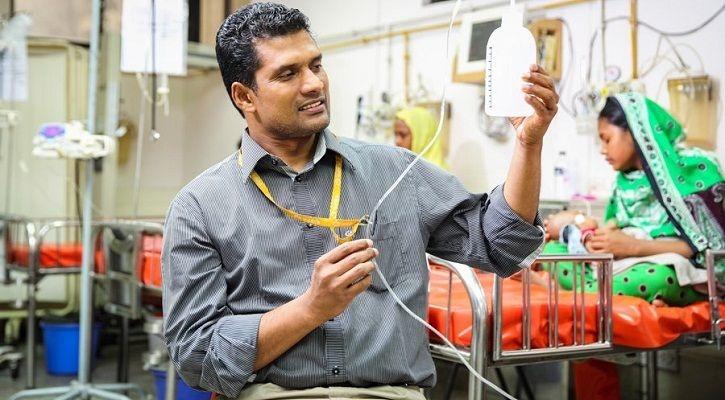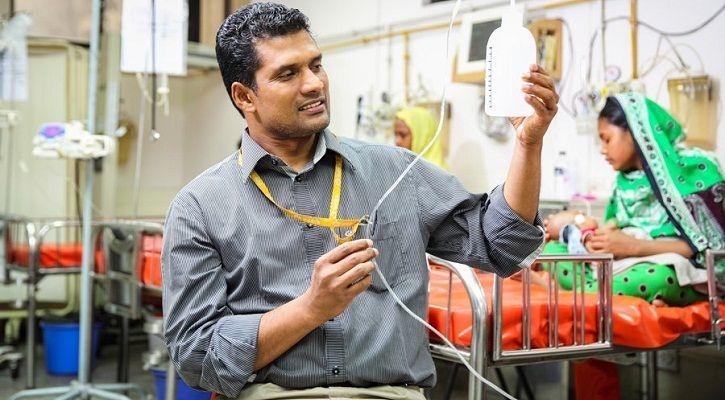Babies With Pneumonia Saved With Plastic Bottles Instead Of Costly Ventilators
Author - Oct 11, 2018

Pneumonia is causing death to infants around the world. While most hospitals in rich countries use costly ventilators, it’s different for poorer countries.
- Nvidia's Chief Scientist Debuts Open-Source Ventilator Model, Much Cheaper Than Traditional Ones
- CO.VID-19 Virus Poses A Deadly Threat To Patients Once They Have To Been Placed On Ventilators
- IIT Roorkee To 3D-Print Face Shields For AIIMS Medical Staff
Pneumonia is among the factors that take the lead in causing death to babies across. And while costly ventilators are used in almost every hospital in rich countries, it’s not the case for poorer countries.
That’s the reason why Mohamad Chisti determined to make use of shampoo bottles.

Last year, 920,000 children under five died from pneumonia. This is an infection from viral, bacterial or fungal in the lungs that forms pus in the alveoli, the oxy supplying agents that we depend on. And breathlessness occurrs when the body forces the lungs to operate harder and quicker while countering the effects.
In poorer countries, it is likely that infants are in lack of nourishment. Therefore, with small bodies, there is not as much energy as needed to hold on the very long labored breathing so they seem to fail. It will be easier thanks to ventilators but their price is higher than $15,000 (Rs 10.8lakh). Consequently, in poorer hospitals, face masks or tubes are used. These are put near the infant’s nose, this alternative may be useful for a healthier infant; yet, it can hardly help a malnourished child breathe.
Mohamad Chisti, a Bangladeshi, is a paediatrician working in Sylhet; on his first night, he witnessed three babies die from pneumonia. According to an article on the Dhaka Tribune, he wished to come up with a better method for the condition treatment. When traveling to Australia, he witnessed a new sort of ventilator used in hospitals called a bubble-CPAP (continuous positive airway pressure) that assists premature babies in breathing, he finally came up with an idea.
This device channels a child’s exhalations through a pipe with its other end steeped in water. From the liquid, the expired air bubbles pop up causing the conduit's air pressure to fluctuate. The pressure fluctuations are flowed back to babies’s lungs and helps the alveoli convert carbon dioxide into oxygen which requires less energy from babies as well as save them from struggling to breathe.
However, it also takes around Rs 4.3 lakh for such bubble-CPAP, too costly for Chisti’s hospital. But he managed to find a solution when he collected a shampoo bottle which was discared with bubbles inside. He succeeded in building his own version of the device at a much lower cost by applying an oxygen source (which is commonly employed with a face mask or tubing anyway), bottle made of plastic full of water and some tubing.
The device's great effectiveness was the most amazing part. Chisti and his team announced their trial outcome with the alternative ventilator in the Dhaka Hospital of the International Centre for Diarrhoeal Disease Research in 2015. Now, the device is frequently used in this hospital resulting a decrease of 75 percent in the number of babies dying from neumonia. This figure is almost the same as the rate of children survival who are cured by hospitals in richer countries all over the world.
Furthermore, the hospital can reduce the expenditure on treating pneumonia by up to 90 percent. This is such a simple math considering that it took him only Rs 90 to form a ventilator which also involves less oxygen compred with the method using face mask.
At present, Dr Chisti wants to test the device in Ethiopia. If everything goes as expected, it’s possible that this tiny ventilator can be used widely in poor hospitals across the globe and become a life saver for thousands of infants.
Featured Stories

Features - Jul 01, 2025
What Are The Fastest Passenger Vehicles Ever Created?

Features - Jun 25, 2025
Japan Hydrogen Breakthrough: Scientists Crack the Clean Energy Code with...

ICT News - Jun 25, 2025
AI Intimidation Tactics: CEOs Turn Flawed Technology Into Employee Fear Machine

Review - Jun 25, 2025
Windows 11 Problems: Is Microsoft's "Best" OS Actually Getting Worse?

Features - Jun 22, 2025
Telegram Founder Pavel Durov Plans to Split $14 Billion Fortune Among 106 Children

ICT News - Jun 22, 2025
Neuralink Telepathy Chip Enables Quadriplegic Rob Greiner to Control Games with...

Features - Jun 21, 2025
This Over $100 Bottle Has Nothing But Fresh Air Inside

Features - Jun 18, 2025
Best Mobile VPN Apps for Gaming 2025: Complete Guide

Features - Jun 18, 2025
A Math Formula Tells Us How Long Everything Will Live

Features - Jun 16, 2025
Comments
Sort by Newest | Popular